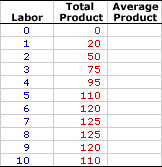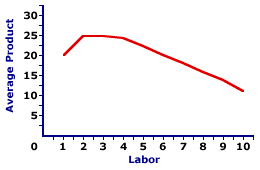
|
|
COMMON MARKET: An agreement among two or more nations to eliminate trade restrictions with each other, to adopt a common trade policy with other nations, and to allow free movement of resources among their countries. There is, however, no effort to adopt common monetary or fiscal policies. This is considered the third of four levels of integration among nations. Customs union, economic union, and free-trade area are the other three levels.
Visit the GLOSS*arama
|
|


|

|
                           AVERAGE PRODUCT: The quantity of total output produced per unit of a variable input, holding all other inputs fixed. Average product, usually abbreviated AP, is found by dividing total product by the quantity of the variable input. Average product, which occasionally goes by the alias average physical product (APP), is one of two measures derived from total product. The other is marginal product. Average product is the per unit production of a firm. Conceptually, it is simply the arithmetic mean of total product calculated for each variable input over a whole range of variable input quantities. Average product is generally considered less important than total product and marginal product in the analysis of short-run production.The formula for specifying and calculating average product from total product is given as: | average product | = | total product
variable input |
Average ProductionThe table at the right summarizes the hourly production by Waldo's TexMex Taco World of Super Deluxe TexMex Gargantuan Tacos (with sour cream and jalapeno peppers). The total product numbers presented can be used to derive the average product.| Average Taco Product |  |
The column on the left is the variable input, specifically the number of workers employed by Waldo's TexMex Taco World, which ranges from 0 to 10. The column to the right is the total product, the total number of TexMex Gargantuan Tacos produced, which ranges from a low of 0 to a high of 125 before declining to 110. Keep in mind that the taco production from these workers depends on a given amount of fixed inputs, Waldo's TexMex Taco World restaurant and all of the capital that goes with it.Not yet shown in this table is average product. This deficiency can be easily remedied. - First, consider the average product for Waldo's TexMex Taco World workforce if Waldo employs only one worker. With one worker, total production is 20 Gargantuan Tacos each hour. Averaging this total production of 20 tacos over the variable input of one worker, gives an average product of 20 Gargantuan Tacos. Click the [One] button to display the average product for one worker.
- Now consider the average product if Waldo's employs two workers. In this case, the total hourly production is 50 Gargantuan Tacos. Dividing 50 tacos by two workers gives an average product of 25 Gargantuan Tacos. Click the [Two] button to display the average product for two workers.
- Consider one more calculation. If Waldo's employs three workers, the total hourly production increases to 75 Gargantuan Tacos. Dividing 75 tacos by three workers results in an average product of 25 Gargantuan Tacos. Click the [Three] button to display the average product for three workers.
The remaining average product values can be derived in a similar manner. To reveal the entire column of average product values, click the [Others] button. Please feel free to spot check the math on a few of these numbers by dividing the total product by the quantity of the variable input.An observation or three about this column of numbers is in order. - First, average product increases for the first two workers, reaches a peak of 25 tacos per worker per hour with either two or three workers employed, then declines thereafter.
- Second, this decline in average product is indirectly caused by the law of diminishing marginal returns.
- Third, while it might not be obvious from this table, average product continues to decline as Waldo's workforce expands, but average product is NEVER negative. To have a negative average product, total product must be negative, and that just does not make sense.
The Average Product Curve| Average Product Curve |  |
The average product curve is a graphical representation of the relation between average product and the variable input. The average product curve for Gargantuan Taco production is displayed to the right.The "general" slope of this curve is negative, with per unit output lower for larger workforces. However, the average product curve is actually "hump" shaped, with a positive slope giving way to a negative slope. Consistent with the numbers in the table, the curve reaches a peak of 25 Gargantuan Tacos at both 2 and 3 workers before the slope turns negative. Total and MarginalTwo related product measures are total product and marginal product.- Total Product: This is the total quantity of output produced by a firm for a given quantity of inputs. Total product is the foundation upon which the analysis of short-run production for a firm is based. It also provides the basis for calculating average product. If, for example, Waldo's TexMex Taco World has a staff of 5 that generates a total product of 110 tacos, then average product is 22 tacos.
- Marginal Product: This is the change in total product resulting from a change in the number of workers. Marginal product indicates how the total production of TexMex Gargantuan Tacos changes when an extra worker is hired or fired. For example, hiring a 5th worker means that Waldo's TexMex Taco World total product increases from 95 to 110 tacos. The addition of a 5th worker results in the production of an additional 15 TexMex Gargantuan Tacos.

Recommended Citation:AVERAGE PRODUCT, AmosWEB Encyclonomic WEB*pedia, http://www.AmosWEB.com, AmosWEB LLC, 2000-2025. [Accessed: July 18, 2025].
Check Out These Related Terms... | | | | | | | | | |
Or For A Little Background... | | | | | | | | | | | | | |
And For Further Study... | | | | | | | | | |
Search Again?
Back to the WEB*pedia
|



|

|
RED AGGRESSERINE
[What's This?]
Today, you are likely to spend a great deal of time at a flea market wanting to buy either a weathervane with a cow on top or a box of multi-colored, plastic paper clips. Be on the lookout for telephone calls from long-lost relatives.
Your Complete Scope
This isn't me! What am I?
|

|
|
Francis Bacon (1561-1626), a champion of the scientific method, died when he caught a severe cold while attempting to preserve a chicken by filling it with snow.
|

|
|
"A winner is someone who recognizes his God-given talents, works his tail off to develop them into skills, and uses those skills to accomplish his goals. " -- Larry Bird, basketball player
|

|
PPI
Producer Price Index
|

|
|
Tell us what you think about AmosWEB. Like what you see? Have suggestions for improvements? Let us know. Click the User Feedback link.
User Feedback
|


|


